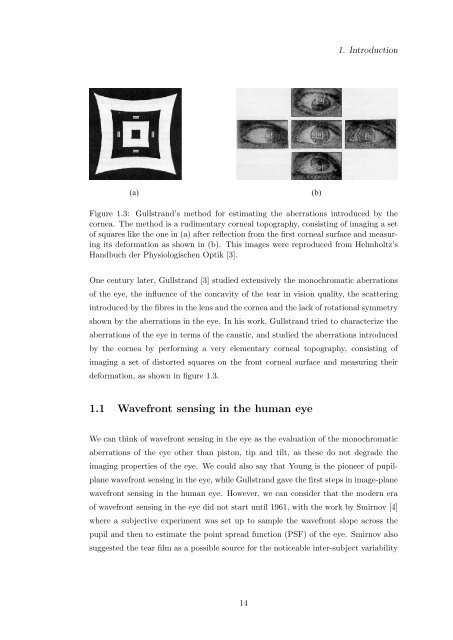Alfredo Dubra's PhD thesis - Imperial College London
Alfredo Dubra's PhD thesis - Imperial College London
Alfredo Dubra's PhD thesis - Imperial College London
You also want an ePaper? Increase the reach of your titles
YUMPU automatically turns print PDFs into web optimized ePapers that Google loves.
1. Introduction<br />
(a)<br />
(b)<br />
Figure 1.3: Gullstrand’s method for estimating the aberrations introduced by the<br />
cornea. The method is a rudimentary corneal topography, consisting of imaging a set<br />
of squares like the one in (a) after reflection from the first corneal surface and measuring<br />
its deformation as shown in (b). This images were reproduced from Helmholtz’s<br />
Handbuch der Physiologischen Optik [3].<br />
One century later, Gullstrand [3] studied extensively the monochromatic aberrations<br />
of the eye, the influence of the concavity of the tear in vision quality, the scattering<br />
introduced by the fibres in the lens and the cornea and the lack of rotational symmetry<br />
shown by the aberrations in the eye. In his work, Gullstrand tried to characterize the<br />
aberrations of the eye in terms of the caustic, and studied the aberrations introduced<br />
by the cornea by performing a very elementary corneal topography, consisting of<br />
imaging a set of distorted squares on the front corneal surface and measuring their<br />
deformation, as shown in figure 1.3.<br />
1.1 Wavefront sensing in the human eye<br />
We can think of wavefront sensing in the eye as the evaluation of the monochromatic<br />
aberrations of the eye other than piston, tip and tilt, as these do not degrade the<br />
imaging properties of the eye. We could also say that Young is the pioneer of pupilplane<br />
wavefront sensing in the eye, while Gullstrand gave the first steps in image-plane<br />
wavefront sensing in the human eye. However, we can consider that the modern era<br />
of wavefront sensing in the eye did not start until 1961, with the work by Smirnov [4]<br />
where a subjective experiment was set up to sample the wavefront slope across the<br />
pupil and then to estimate the point spread function (PSF) of the eye. Smirnov also<br />
suggested the tear film as a possible source for the noticeable inter-subject variability<br />
14

















